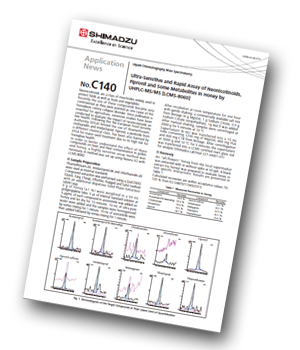Shimadzu has produced an application note describing the ultra-sensitive method for quantitating Acetamiprid, Acetamiprid-N-desmethyl, Clothianidin, Dinotefuran, Fipronil, Fipronil sulfone, Imidacloprid, Nitenpyram, Thiacloprid and Thiamethoxam in honey by LC-MS/MS.
 Introduction
Introduction
The use of neonicotinoids, a widely-used class of insecticides, has recently become very controversial as they were pointed as one cause of the honey bees colony collapse disorder. Since pollination is essential for agriculture, extensive studies have been conducted to evaluate the impact of neonicotinoids on bee health, which led to the decision of the European Food Security Authority to strictly limit the use of these pesticides. Consequently, a highly sensitive assay method is now necessary to screen for adherence as well as for delivering a better tool to this emerging research field.
Real Sample Analysis
Nine honey samples purchased at the local supermarket or used as raw materials in cosmetics (orange tree honey) were assayed as unknowns. All tested honeys showed concentrations far below the authorized maximum residue limit but thanks to the very high sensitivity reached, even low concentrations of neonicotinoids were quantified.
Results and Discussion
A method for ultra sensitive assay of neonicotinoids in honey was set up. LLOQ of single-digit ppt was reached for 6 of the target compounds. Recoveries in honey matrix after QuEChERS extraction was shown to be within the acceptance values 70-120% from EU SANTE/11945/2015 for all compounds. The method was used to quantitate the neonicotinoids in commercially available honey brands far below the authorized maximum residue limit.
Conclusion
The sample preparation was simple but provided excellent recoveries. The injection mode used prevented the use of tedious evaporation/reconstitution or dilution steps. Thanks to the high sensitivity obtained an assay in real samples at very low levels, far under the regulated residue levels, was possible. Furthermore, even at low measured concentrations, the system demonstrated its stability after a long analytical series of real samples. This method can be a very efficient support tool to better understand the impact of neonicotinoids on honey bee colonies and could be easily transposed to pollen or bee samples.
By downloading this application note you will learn:
- about an emerging field in food safety, in that the purpose of regulation is to contain environmental impact rather than consumer hazard.




